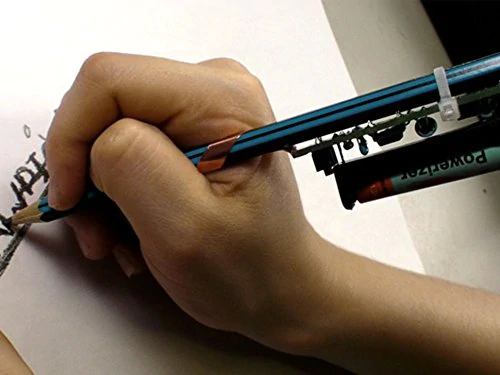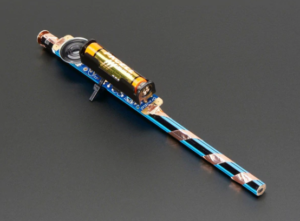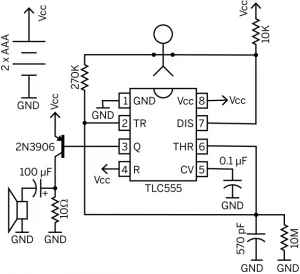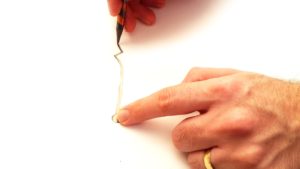
Drawdio
Drawdio is a very simple musical synthesizer that makes sounds by using the electrical qualities of pencil graphite. Therefore, as you draw on a piece of paper, a musical note is made.
Components:
- AAA battery (runs for many hours)
- Pencil (the softer the lead the better)
Working Principle:
Jay Silver created Drawdio, which exploits the electrical qualities of graphite in a pencil to produce various musical tones.

With this version of the drawdio, you can turn a sheet of paper into your own musical instrument, taking the modest musical synthesiser to the next level! This well-thought-out drawdio package includes an 8b graphite pencil that produces broad, smooth lines.
Circuit diagram:

The 555 timer chip is at the heart of the Drawdio circuit. This variant employs a low-power version of the 555 that can operate at 3 volts, but it also functions like a conventional 555. The 555 runs in so-called astable mode when wired this way, emitting a continuous stream of pulses from pin 3. Change the values of the resistors and capacitors connected to pins 2 and 7 to adjust the frequency of the pulses. The frequency output by the 555 naturally varies depending on what she or he is touching because the connections are engineered to put the user’s body into the resistive loop. The transistor amplifies the pulses, which then emerge as audible sound from the speaker.
How to use it:

To use your drawdio pencil, make a large dot for one finger to sit on as seen above, then draw away from it in any form you wish. The finger on the dot completes the circuit via the body (which is entirely safe, of course), connecting with the copper tape on the pencil with your other hand. To get a feel for how it works, you may start with a straight line. Once you’ve drawn a line, touch it at varied intervals or run your pencil along it to create sounds with varying frequencies and notes.
If you don’t hear anything the first time, try making the lines thicker, thinner, shorter, and longer to see what works best for you. The bigger the range of notes, the longer the line is, starting with lower frequency closer to the touch dot and increasing as it gets further away. Similarly, the higher the pitch, the wider and heavier the line (therefore the conductivity of the graphite). To make it even more enjoyable, swap the pencil and hold it on the dot while running your finger along the line!
When you hold Drawdio in your hand, your entire body becomes a resistive loop, allowing you to perform a variety of amusing tricks.
Instructions:
- First, draw a big dot on a piece of paper
- Then moisten the tip of your finger, on the other hand, and touch the dot while drawing a line away from it on the page.
- Jump back and forth along the line, and you can play different notes and even, with a bit of practice, entire melodies.
Links:
https://www.rakits.co.uk/drawdio/
“Drawdio” Musical Pencil – Make:
Weekend Projects – “Drawdio” Musical Pencil